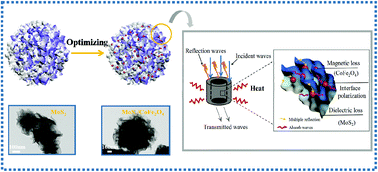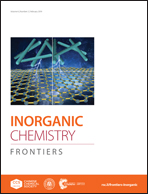Two-dimensional MoS2 modified using CoFe2O4 nanoparticles with enhanced microwave response in the X and Ku band†
Abstract
In recent years, two-dimensional inorganic materials (MoS2) have been promising candidates for EM wave absorber because of their high specific surface area, excellent electronic properties and dielectric loss caused by polymorphism. Nevertheless, the poor impedance matching of individual MoS2 limited its microwave absorption performance. Optimizing the impedance matching of microwave absorber can be an effective way to achieve electromagnetic wave attenuation. In this study, we deposited CoFe2O4 magnetic nanoparticles on the surface of MoS2 nanosheets using reasonable hydrothermal reactions to optimize its poor impedance and enhance interfacial polarization. The MC-6 composite (mMoS2 : mCoFe2O4 = 6 : 1) exhibited excellent microwave absorption capability. The minimum reflection loss (RL) reached −55.3 dB at 16.24 GHz (Ku band) and the effective absorption bandwidth (<−10 dB) was measured to be 6.26 GHz (X band) with a thickness of 1.6 mm. This study confirms that optimizing impedance matching and interfacial polarization of MoS2-based composites play a key role in the microwave response. Moreover, the reasonable optimization of impedance matching enables regulation of the effective bandwidth and strong absorption intensity.



 Please wait while we load your content...
Please wait while we load your content...